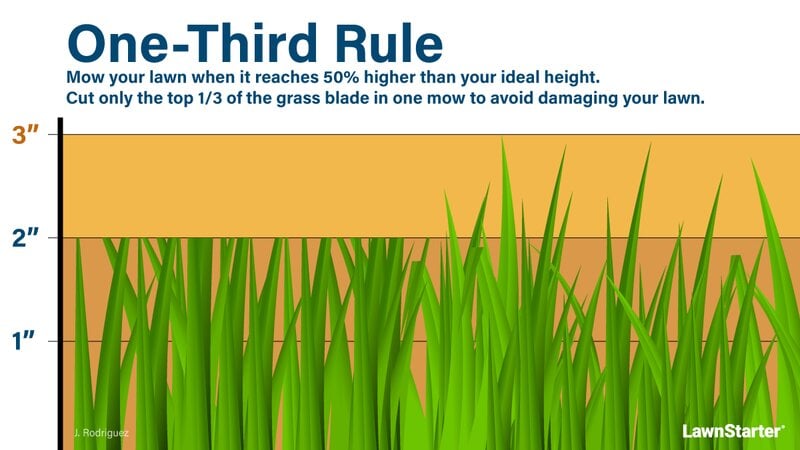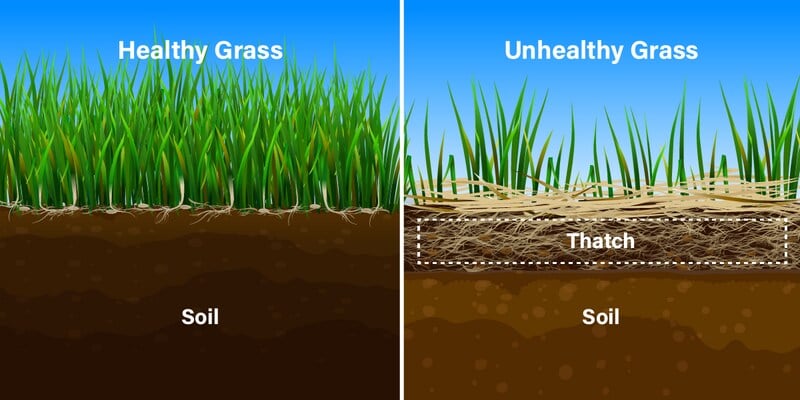
Learning how to dormant seed your lawn is easy. To dormant seed, plant grass in the fall when it’s chilly but before the soil freezes, typically around Halloween or Thanksgiving. Your seeds won’t germinate because your lawn is dormant, but it will give cool-season grasses a head start growing in early spring.
This method works best in northern states, where the ground freezes all winter and they grow cool-season grasses. Our guide explains everything you need to know to get started.
What’s Dormant Seeding?
Dormant seeding is an overseeding method typically performed in late fall when the air is 35°F to 40°F, and the soil is 45°F to 50°F. Cool-season grass seeds lay dormant all winter and germinate in early spring.
Cool-season grass’s natural growth cycle inspires sprouting sooner when seeds are sown right before winter. The seeds germinate in early spring when the soil is 50 to 65°F. With dormant seeding, the grass seed is already in the ground and ready to sprout.
6 Steps to Dormant Seed Your Lawn
To dormant seed your lawn, follow these simple steps:
- Prepare the Lawn
- Loosen the Soil and Remove Thatch
- Sow the Seeds
- Water the Ground
- Wait Out the Winter
- See Sprouting in Spring
Step 1: Prepare the Lawn

Prior to planting, rid the lawn of anything that may prevent seed-to-soil contact:
- Mow your lawn a little low, about 2 inches.
- Use the one-third rule; never mow more than ⅓ of the grass’s height in a single mow.
- If your grass is more than 50% higher than ideal, gradually cut down the height over several mows.
- Clean yard debris, including twigs, rocks, and leaves.
- Remove other obstructions, such as lawn furniture and toys.
Step 2: Loosen the Soil and Remove Thatch

Loose soil promotes healthy seed-to-soil contact. Use a rake to loosen about ¼-inch of topsoil, removing any thatch.
Use the right type of rake for the job:
- Small spots: Use a hand rake.
- Large areas: Gently use a power rake or vertical mower.
Clean up any surface debris so the soil is super penetrable for seeds.
Step 3: Sow the Seeds
Evenly apply cool-season grass seeds, such as fescue, Kentucky bluegrass, or perennial ryegrass.
Use a tool that won’t damage the soil:
- Small spots: Use a hand rake to mix the seeds into the soil or lay them with a hand-held fertilizer spreader.
- Large areas: Walk-behind broadcast spreaders work great on large areas. Avoid using a tow-behind because their weight could cause soil compaction.
DON’T sow when there is snow on the ground, and never apply fertilizer.
Seeds sown in the off-season are less likely to sprout, so we suggest planting a little more grass seed than you would in the growing season. Jim Murphy, a specialist at Rutgers’ Center for Turfgrass Science, suggests using 30% – 50% more seed if you think it might be a mild winter.
Step 4: Water the Ground
Lightly water the seeded areas with 0.05 to 0.10 inches of water.
Step 5: Wait Out the Winter
Your seeds should stay safely stowed beneath the snow cover, so there’s nothing for you to do until spring. Break out the hot cocoa and a good book while patiently waiting out the winter.
Step 6: See Sprouting in Spring

Seeds usually sprout around late April or early May. Make sure the new seedlings have everything they need to thrive:
- Water the lawn, following watering guidelines for new grass. For the first 2 weeks, water up to twice daily, ensuring ½ to 1 inch of topsoil is moist. During weeks 3 and 4, reduce watering to once daily unless there’s extreme heat or drought.
- Fertilizer: The best lawn fertilizers for new grass contain phosphorus for deep rooting and organic matter for soil sustainability. We like Sta-Green Fertilizer plus Soil Conditioner.
- Weed preventer: Since the grass seeds sprouted sooner, they contend with fewer weeds. You may still want to use a pre-emergent herbicide, but be leery. Most grassy weed and crabgrass preventers kill new grass. Use a product that’s marked safe for seeding and apply several days after the soil reaches 55°F.
FAQ About Dormant Seeding
How do I give my dormant seeds the best shot at survival?
The success of your seeds depends mainly on seed-to-soil contact and weather. Give them the best shot at survival by:
- Properly preparing the soil
- Planting at the right time
- Praying for winter-long freezing temperatures and snow cover
Will dormant seeding fix my lawn?
Dormant seeding makes cool-season lawns more lush when:
- They are thin
- They have bare spots
If your lawn is thick and healthy, it’s better to overseed in spring or early fall. However, homeowners needing a total lawn restoration should consider slice seeding.
Can I seed after the ground freezes?
Frost seeding is an overseeding method done in frozen soil. It works best on pastures where livestock helps with seed-to-soil contact.
When to Hire a Lawn Treatment Pro
Seeding is a finicky process that relies on the right weather. If you don’t like taking chances with your lawn, hire a pro. LawnStarter connects you to lawn treatment pros with the experience and know-how to make your lawn lush. We’re your one-stop shop for complete lawn care.
Sources:
- Browning, Sarah. “Dormant Lawn Seeding.” Nebraska Extension in Lancaster County. University of Nebraska Lincoln
- “Discuss the steps in seedbed preparation“. Forage Information System. Oregon State University
- “Dormant seeding your lawn“. University of Minnesota Extension
- “Frost Seeding.” Illinois Grazing Manual Fact Sheet. United States Department of Agriculture
- Murphy, Jim. (2023, February 20). “Mild winter, what does it mean for overseeding of turf or dormant seeding?“. Center for Turfgrass Science. Rutgers, The State University of New Jersey
LawnStarter participates in an affiliate advertising program. LawnStarter may earn revenue from products promoted in this article.
Main Photo Credit: faithie / Adobe Stock Free / License